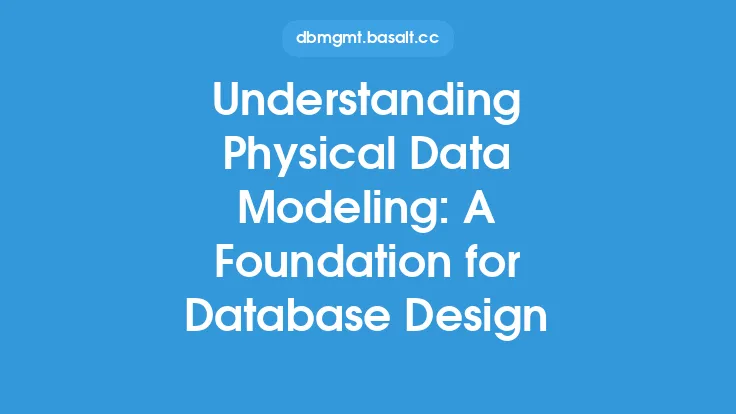Data warehousing is a crucial aspect of business intelligence, enabling organizations to make informed decisions by providing a centralized repository of data. At the heart of a data warehouse is a well-designed data model, which serves as the foundation for storing, managing, and analyzing large volumes of data. A data model for a data warehouse is essentially a conceptual representation of the data, outlining the relationships between different entities, attributes, and facts. In this article, we will delve into the fundamentals of data warehouse design from a data modeling perspective, exploring the key concepts, principles, and best practices that underpin a successful data warehousing initiative.
Introduction to Data Modeling for Data Warehousing
Data modeling for data warehousing involves creating a conceptual, logical, and physical model of the data, which is tailored to meet the specific needs of business intelligence and analytics. The primary goal of data modeling in this context is to design a data structure that can efficiently store and manage large amounts of data, while also providing fast query performance and supporting complex analytics. A well-designed data model is essential for ensuring data consistency, reducing data redundancy, and improving data integrity. It also enables organizations to define a common vocabulary and set of metrics, which is critical for making informed decisions.
Data Warehouse Architecture
A data warehouse architecture typically consists of several layers, including the source systems, data staging area, data warehouse, and data marts. The source systems provide the raw data, which is then extracted, transformed, and loaded (ETL) into the data staging area. The data staging area is used to clean, transform, and format the data for loading into the data warehouse. The data warehouse is the central repository of data, which is designed to support business intelligence and analytics. Data marts, on the other hand, are smaller, specialized repositories of data that are designed to support specific business needs or departments. A data model for a data warehouse must take into account the various layers of the architecture and ensure that data is properly integrated and aligned across each layer.
Data Modeling Concepts
There are several key data modeling concepts that are relevant to data warehousing, including entities, attributes, facts, and dimensions. Entities are objects or concepts that have independent existence, such as customers, products, or orders. Attributes are the characteristics or properties of entities, such as customer name, product description, or order date. Facts are measurable events or transactions, such as sales, revenue, or customer interactions. Dimensions are the categories or perspectives that are used to analyze facts, such as time, geography, or product category. A data model for a data warehouse must carefully define and relate these concepts to ensure that data is properly organized and structured.
Data Modeling Techniques
There are several data modeling techniques that are commonly used in data warehousing, including entity-relationship modeling, dimensional modeling, and fact-table modeling. Entity-relationship modeling is a technique that is used to model the relationships between entities and attributes. Dimensional modeling is a technique that is used to model facts and dimensions, and is particularly well-suited to data warehousing. Fact-table modeling is a technique that is used to model measurable events or transactions, and is often used in conjunction with dimensional modeling. A data model for a data warehouse must carefully select and apply these techniques to ensure that data is properly structured and organized.
Data Warehouse Schema Design
A data warehouse schema is the physical implementation of the data model, and is typically designed using a combination of tables, indexes, and views. There are several types of schema designs that are commonly used in data warehousing, including star schemas, snowflake schemas, and fact constellation schemas. A star schema is a design that consists of a central fact table surrounded by dimension tables. A snowflake schema is a design that consists of a central fact table surrounded by dimension tables, which are further normalized into multiple related tables. A fact constellation schema is a design that consists of multiple fact tables, each of which is surrounded by a set of dimension tables. A data model for a data warehouse must carefully design the schema to ensure that data is properly organized and structured, and that query performance is optimized.
Data Modeling Tools and Technologies
There are several data modeling tools and technologies that are available to support data warehousing, including data modeling software, database management systems, and data integration tools. Data modeling software, such as ERwin or PowerDesigner, provides a graphical interface for designing and implementing data models. Database management systems, such as Oracle or SQL Server, provide a platform for implementing and managing data warehouses. Data integration tools, such as Informatica or Talend, provide a platform for extracting, transforming, and loading data into the data warehouse. A data model for a data warehouse must carefully select and apply these tools and technologies to ensure that data is properly designed, implemented, and managed.
Best Practices for Data Modeling in Data Warehousing
There are several best practices that should be followed when designing a data model for a data warehouse, including defining a clear set of requirements, using a standardized data modeling notation, and ensuring data quality and integrity. A clear set of requirements is essential for ensuring that the data model meets the needs of business intelligence and analytics. A standardized data modeling notation, such as entity-relationship modeling or dimensional modeling, is essential for ensuring that the data model is consistent and well-structured. Data quality and integrity are critical for ensuring that the data warehouse provides accurate and reliable insights. A data model for a data warehouse must carefully follow these best practices to ensure that data is properly designed, implemented, and managed.
Conclusion
In conclusion, data modeling is a critical aspect of data warehousing, providing a foundation for storing, managing, and analyzing large volumes of data. A well-designed data model is essential for ensuring data consistency, reducing data redundancy, and improving data integrity. By following best practices and using standardized data modeling techniques and tools, organizations can create a data model that meets the needs of business intelligence and analytics, and provides a solid foundation for making informed decisions. Whether you are designing a new data warehouse or optimizing an existing one, a careful and well-structured data model is essential for ensuring success.





